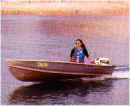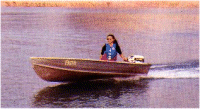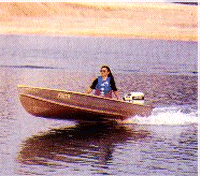



 Car Toppers Part 3 - Handling a small boat
Car Toppers Part 3 - Handling a small boatby Chris Tan I have a friend who waited for two years before finally purchasing a car-topper. However, to the bewilderment of all his fishing buddies, his boat is still sitting in his garden, dry as a bone, for the past seven months! It has been a subject of great debate when his boat will go on its maiden voyage! We eagerly await the day when we can enjoy being on the water in his boat. When it does, I hope the information here will be useful to him. Handling a small boat like a car-topper is a simple affair. I would like to enlighten the new boat owners the basic concepts of safe boat handling. Some know how, and with a dash of common sense, you can have a great time! I would recommend that the novice boat handler be thoroughly acquainted with the characteristics of the boat and engine before venturing into "treacherous" waters. Rivers, estuaries or long trips on open water (large reservoirs) should be left to the more experienced. Calm waters like lakes are safe waters to familiarise oneself with the new boat and outboard motor. Read the manual of your outboard engine to be familiar with its operations, limits and what the little red buttons or black levers are for. Smashing the bow of the boat on the bank, thinking the engine is in reverse, is not an unfamiliar sight! Starting the engine in gear can be hazardous. (Make safe operations of your boat the priority). Know how to change the shear pin if your propeller uses one. We once had to change the pin on a 3.3hp engine four times in Taman Negara. The pin kept shearing every time the gear box hit an object. Handling the boat was made more difficult due to the fact that the engine was way under powered for the size of the boat, and the gear box was located too deep for running in shallow rivers. We ran out of shear pins and had to make our own out of nails obtained from a passing boat. The first time a friend and I tried rowing his boat, we spent a lot of time rowing in circles and zig-zags! If rowing is your mode of propulsion, make sure you have the rowing skills before endeavouring to fish in waters with currents or even with a breeze present, as these natural elements could sweep you away from your chosen spot! Returning to the place of embarkation can be challenging! Familiarise yourself with the operation of raising and lowering the motor. The larger ones have a shallow running position. Do not hesitate to use it in the shallow running position in shallow waters. By all means slow down in the shallows. In confined waters with underwater obstructions, take your time and motor gently and slowly along. All you will achieve by tearing along at full speed along a narrow channel, around sand bars or sunken logs and trees is a broken propeller or damaged gearbox. If you are fortunate, the outboard motor safety release will let the motor flip up without any damage, but in the long run the gearbox and propeller will suffer damage that accumulates over time. The real danger of hitting an obstruction at high speed, is getting flung out of the boat and knocked unconscious. This is one good reason to wear a life jacket, even if you are a strong swimmer. Some of the outboard engines have a switch that is attached to the driver by a cord. If the driver is flung overboard, the engine ignition is switched off. This prevents the boat from running away or even more tragically, returning and running over the former occupants of the boat! Use this feature! The term "plane" has been used several times in my previous articles. A simple way to describe it is when the boat begins to skim over the surface of the water. This happens when the boat's speed is fast enough to overcome the weight of the boat. Of course the size and shape affects the speed at which the boat planes for a certain weight. Another way of finding out when the boat is not planing is to run the boat at high speed. Slowly back off the throttle. Observe the smooth water behind the boat. When the bubbly foamy part of the wake reaches the back of the boat the hull has stopped planing and is now displacing the water. Examples of boats that do not plane are tong-kangs or canoes. These boats are called displacement boats as they displace the water instead of skimming over it.  The boat is planing most efficiently when the angle of the hull to water surface gives the least water resistance for maximum
lift.
The boat is planing most efficiently when the angle of the hull to water surface gives the least water resistance for maximum
lift. When the boat prow is too low, a very large surface area is exposed to the water, producing a lot of drag.
When the boat prow is too low, a very large surface area is exposed to the water, producing a lot of drag.
 If the prow is too high there is less hull area in the water but the greater angle between the surface of the water and the hull creates excessive drag.
If the prow is too high there is less hull area in the water but the greater angle between the surface of the water and the hull creates excessive drag.
There are certain methods to get your boat to plane efficiently. Two of the most common ways are balancing the load in the boat and trimming the engine. Normally the two go hand in hand, as the load changes on different trips. Finding the balance is a matter of experience acquired with time. Moving about heavy things like the fuel tank and passengers make a significant difference in the way the boat rides. For example, if the boat rides with prow too high, you could move the fuel tank forward or get a fat friend to sit in front! The second method of adjusting the planing attitude of the boat is by changing the trim of the engine. This is changing the angle of the propeller shaft to the transom. Negative trim or trimming in causes the prow to dig down as the thrust of the engine is directed slightly downwards, lifting the rear part of the hull. Positive trim or trimming out pushes the aft hull down, causing the reverse of negative trim, pushing the transom down and lifting the prow. Ideally the engine should be trimmed to have the thrust of the propeller totally horizontal. When some of the thrust is directed up or down, some thrust is spent pushing the transom up or down, thus decreasing the thrust available to propel the boat forward. Finding the right combination of weight distribution in the boat and the correct trim setting will take some time. Do not hesitate to stop the boat to redistribute the load or adjust the engine trim, as the end result is worth it in fuel consumption and boat speed. The perfect plane is when the boat just starts to porpoise (the prow of the boat oscillating up and down), then trim in slightly or move a heavy item forward so that it stops. Most car-toppers I have used have a zone between displacement and planing. It is when the boat struggles to achieve the plane on acceleration, with the prow stuck high in the air and the engine struggling at half throttle. This zone is often called the "hole" because the engine has to use brute strength to climb out of it. The end result is, there are only two speeds the boat travels at comfortably, slowly at idle or quarter throttle, and high speed at three quarter throttle and above. Between these two throttle settings the boat runs very slowly in the "hole" until there is sufficient power to push it out of the "hole". In other words there is no cruising around in the "hole" and the boat has a very high minimum planing speed. Having a low planing speed is important in rough water. Moving the weight forward or trimming in the engine initially helps but once the boat is on plane the prow is too low making it inefficient. If you are fortunate enough to have a boat that makes a smooth transition from displacement to plane, you are fortunate. One gadget or accessory I found invaluable is the outboard motor hydrofoil. It is basically a pair of "wings" bolted on to the cavitation plate of the outboard motor. In some boats installing this hydrofoil helps. In my boat it has virtually eliminated the problem of the "hole". I can cruise at all speeds comfortably. It makes a seamless transition from displacement to full planing in a flat attitude. In addition it improves stability in rough water, fuel consumption and speed. Generally for most engines the most efficient speed would be when the engine is just below full throttle, which is about 90% rpm. This will give you the best fuel consumption in most cases. Very important for long range trips. Handling the boat when the conditions deteriorate differ. When running into chop, keep the prow low, so the bow cuts through the waves to reduce the bouncing of the boat, especially at the front of the boat. Transferring some weight forward is one solution but the norm would be to use negative trim to keep the prow down. Slow down if necessary otherwise the person sitting in front will not be a friend in the future! However for small boats like car-toppers, if the waves start getting higher than the boat, the above method would have the prow cutting into the waves with the water cascading in over the prow. You are in big trouble! In this case you should not be out there anyway, but if you are, put on your life-jackets, move the weight to the rear and trim the engine out. Moving the weight at this time is more important than trimming the engine as the waves will be too high to have the throttle open enough for the thrust of the engine to make a difference. By moving the weight back, the prow is lightened, allowing the prow to lift up over the waves. Naturally in this case your main intention is to prevent the swamping of the boat, so go slow and do whatever is necessary to survive! Turn around and run with the waves if you have to. This brings us to the issue of overloading. Too many times have I heard of small boats being swamped at sea or in large reservoirs. The accidents usually happened when the boat had too many people in it. When the boat is overloaded, it has very little freeboard or clearance above water level, not to mention it probably cannot achieve plane. Thus the small boat is unable to rise with the swell or the waves, and so it gets swamped. The manufacturer specifies a maximum number of persons and weight capacity. It would be prudent to heed the maximum limits and wise to keep considerably below the maximum limit in exposed waters. When the waves are coming from behind, keeping the boat the same pace as the waves will keep you dry. If the boat cannot maintain sufficient speed and the waves catch up from the rear, water will swamp over the transom. In this case it would be safer to turn around to face the waves. However when the boat can run faster than the waves, trim the engine out (positive trim) to keep the prow high. This is to prevent the prow from plunging into the water when the boat rises over the crest of the wave and descends on the steep front edge of the wave (the back of the wave is gradual in comparison to the front). The basic principals of boat handling here is not the rule but a guide. Keep in mind that different hulls have slightly different handling characteristics. If you come across better ways of handling a boat safely and efficiently, by all means, use them! All this may seem a bit dry and boring but it will keep you literally dry! With experience boat handling will become second nature when you are on the water. Then the main concern will be, are the fish biting? |